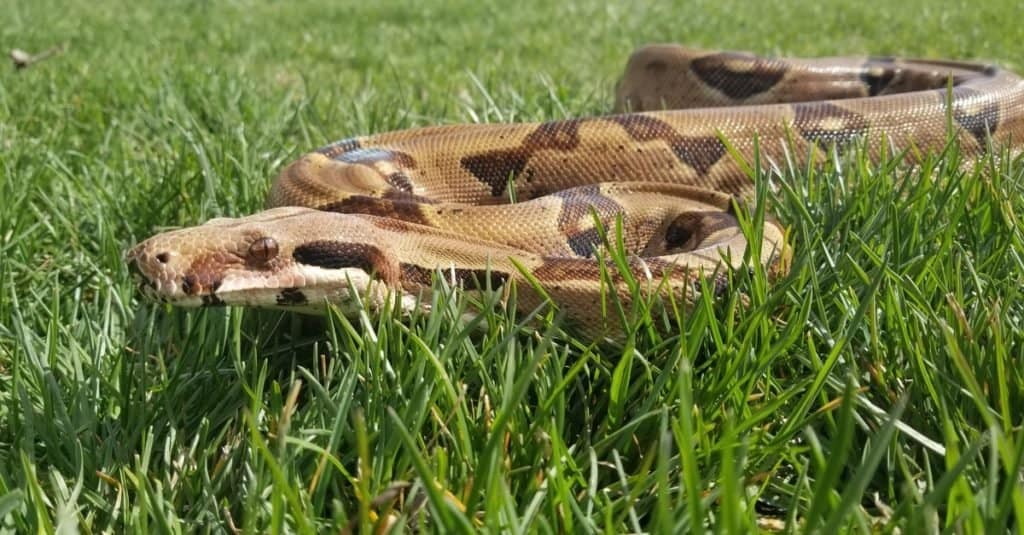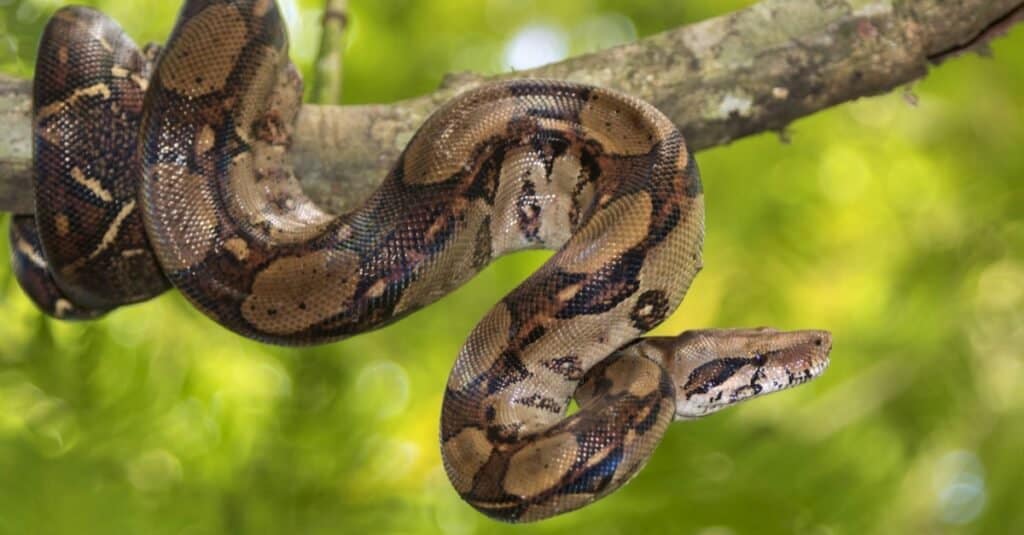Discover the Largest Boa Constrictor Ever Caught
#mobileSnakeQuizControls { overflow: hidden; text-overflow: ellipsis; white-space: nowrap; }
@media (min-width: 481px) {
.mobile-top-content {
display: none;
}
}
#mobileTopContentCTACarouselControls { overflow: hidden; text-overflow: ellipsis; white-space: nowrap; }
.mobile-top-content .more { color: #fff; }
.mobile-top-content a { color: #fff; text-decoration: underline; }
.mobile-top-content a:hover { color: #fff; text-decoration: underline; }
@media (max-width: 480px) {
.mobile-top-content {
background-color: #06a10b;
color: #fff;
text-align: center;
/*height: 60px;
padding-top:5px;*/
font-size:80%;
/* display: block; */
margin: 0px -30px;
}
}
Key Points
- Boa constrictors are a common species of snake, known for their large size and method of killing prey.
- Many people choose boas as pets because of their docile nature and easy care.
- People often believe boas to grow larger than they actually do.
We’ve all heard of boa constrictors. We’ve also heard of pythons and anacondas, two other massive snakes. But, would you believe that there are actually at least ten different subspecies colloquially known as boa constrictors? Like ball pythons and corn snakes, the boa has not escaped the notice of snake enthusiasts looking for a pet. The most common species of pet boa constrictor are the boa constrictor and the boa constrictor imperator. But, neither of these snakes is the largest boa ever caught.
Here, we’ll take a look at the gargantuan snake we call the boa constrictor. We’ll start by learning more about the species in general, then move on to the boa’s lifecycle and diet. After we’ve learned more about the boa, we’ll dive into just how big they really get. Then, we’ll examine the largest boa ever caught. Finally, we’ll compare boas to anacondas and pythons and see how each of these giants measures up. Then, we’ll go over whether these giants make good pets.
button.pulse {
transform: scale(1); animation: pulse 2s infinite;
box-shadow: 0 0 0 0 rgba(11, 247, 25, 1);
}
@keyframes pulse {
0% { transform: scale(0.90); box-shadow: 0 0 0 0 rgba(11, 247, 25, 0.5); }
60% { transform: scale(1); box-shadow: 0 0 0 15px rgba(11, 247, 25, 0); }
100% { transform: scale(0.90); box-shadow: 0 0 0 0 rgba(11, 247, 25, 0); }
}
Species Profile: Boa Constrictor

Jan Hejda/Shutterstock.com
Boa constrictors come from South America, reigning supreme as the largest snakes around. They have large, long heads with distinct dark markings on the top of the head and around the eyes. They’re light brown to tan, with darker brown or reddish hourglass markings along their back and sides. Many pet boas exhibit even more distinct coloring and patterning due to selective breeding.
Locally, boas prefer to stay close to permanent water sources, like rivers, streams, and wetlands. They’re good swimmers and spend much of their lives in water. But, they can also climb and are sometimes found high in the trees. Wherever they live, they tend to prefer warm, humid air.
Boa Constrictor: Lifecycle
Like many snakes, boa constrictors give birth to live young rather than lay eggs. Females gestate their young for 100-120 days before giving birth to an average of 25 snakelets (though some older females may have as many as 60). The young start life around one foot long and continue to grow throughout their lives. Even the largest boas ever caught started life as tiny newborns. Boas are considered adults by the time they’re 3-4 years old.
Boa Constrictor: Teeth
Many people assume that all snake have vicious fangs at the ready. However, boa constrictors only have small, hooked teeth they utilize to hang onto prey as they slowly constrict them to death. An interesting fact is that, if the teeth fall out for some reason, they will grow back. The jaws of boa constrictors are also specialized to open astonishingly wide in order to swallow large prey.
Boa Constrictor: Diet
As you might have guessed, boa constrictors kill their prey using constriction. Constriction refers to the process of the snake wrapping its muscular body around the prey and squeezing so that the animal cannot breathe. This results in a quick death, after which the boa is free to swallow the prey whole. Boas eat mostly small to medium-sized mammals, birds, and reptiles. The bigger the boa, the larger the prey it can consume.
How Big do Boas Get?

KatKade/Shutterstock.com
Even at birth, boa constrictors are not small. They range from one to two feet long as brand new snakelets, though they grow rapidly in the first four years of life. By the time they’re a year old, they measure between three and four feet long. At three years old, boas measure between six and ten feet on average. They’re considered adults by the time they turn five. After five, their growth slows but never stops entirely.
The largest boas can grow up to twelve feet long, though there are reports of even bigger boas. Their weight depends heavily on the subspecies but ranges from ten pounds to over thirty pounds. Female boas are bigger and usually heavier than males.
The Largest Boa Constrictor Ever Caught

Natalia Kuzmina/Shutterstock.com
According to National Geographic, the largest boa constrictor ever caught measured 18 feet long, though no citation exists for this specimen. So, while it is safe to say that the largest boas grow to at least 10 and even 12 feet long, reports of longer snakes are dubious.
Which is Bigger: Anaconda or Boa?
Boa constrictors are no small fries, but they’re still dwarfed in size by the anaconda. Where boas grow to around 12 feet at maximum, anacondas can reach lengths of 15 feet or more. However, in both types of snakes, females are bigger than males. This means that a large female boa is likely to be larger than a large male anaconda.
But what about green anacondas? Green anacondas are one of the largest snakes on the planet. They far outsize even the largest boa constrictor ever caught. The biggest green anacondas can grow to over 20 feet long and weigh hundreds of pounds.
Which is Bigger: Python or Boa?
Once again, the boa constrictor’s bulk is put to shame by the much larger and longer reticulated python. Reticulated pythons are the largest snakes in the world and can measure over 20 feet long. Like boa constrictors, pythons are non-venomous constrictors and rely on their bulk to kill prey. Reports of pythons reaching lengths of more than 30 feet are greatly exaggerated, and no known specimen of this size has ever been reliably measured.
Do Boa Constrictors Make Good Pets?

New Africa/Shutterstock.com
You don’t have to see the largest boa constrictor ever caught to want a boa of your own. Boas are largely regarded as low maintenance, friendly, and safe to keep as pets. But their tremendous size (generally up to seven feet for captive snakes) means that only those with the proper space should consider getting a pet boa.
If you’re thinking of adding a boa to your family, check state and federal regulations first. Boas, and other snakes, aren’t legal to keep in every state.
Up Next…
Boa constrictors are a fascinating species of snake. Learn more about what they’re capable of in these following articles:
- Boa vs Python: How to Tell Them Apart – Often misidentified as the other, these species have their key differences.
- Alligator vs Giant Boa: Who Would Win in a Fight? – Boas can constrict while alligators death roll, so, who comes out alive?
- What Do Boa Constrictors Eat? 12 Animals they Hunt – Unique hunters, it is interesting to see what these snakes are capable of eating.
Discover the “Monster” Snake 5X Bigger than an Anaconda
Every day A-Z Animals sends out some of the most incredible facts in the world from our free newsletter. Want to discover the 10 most beautiful snakes in the world, a “snake island” where you’re never more than 3 feet from danger, or a “monster” snake 5X larger than an anaconda? Then sign up right now and you’ll start receiving our daily newsletter absolutely free.
More from A-Z Animals
.more-snake-card-image { max-height:140px !important; }
#mobileSnakeQuizControls { overflow: hidden; text-overflow: ellipsis; white-space: nowrap; }
@media (min-width: 481px) {
.mobile-top-content {
display: none;
}
}
#mobileTopContentCTACarouselControls { overflow: hidden; text-overflow: ellipsis; white-space: nowrap; }
.mobile-top-content .more { color: #fff; }
.mobile-top-content a { color: #fff; text-decoration: underline; }
.mobile-top-content a:hover { color: #fff; text-decoration: underline; }
@media (max-width: 480px) {
.mobile-top-content {
background-color: #06a10b;
color: #fff;
text-align: center;
/*height: 60px;
padding-top:5px;*/
font-size:80%;
/* display: block; */
margin: 0px -30px;
}
}
Key Points
- Boa constrictors are a common species of snake, known for their large size and method of killing prey.
- Many people choose boas as pets because of their docile nature and easy care.
- People often believe boas to grow larger than they actually do.
We’ve all heard of boa constrictors. We’ve also heard of pythons and anacondas, two other massive snakes. But, would you believe that there are actually at least ten different subspecies colloquially known as boa constrictors? Like ball pythons and corn snakes, the boa has not escaped the notice of snake enthusiasts looking for a pet. The most common species of pet boa constrictor are the boa constrictor and the boa constrictor imperator. But, neither of these snakes is the largest boa ever caught.
Here, we’ll take a look at the gargantuan snake we call the boa constrictor. We’ll start by learning more about the species in general, then move on to the boa’s lifecycle and diet. After we’ve learned more about the boa, we’ll dive into just how big they really get. Then, we’ll examine the largest boa ever caught. Finally, we’ll compare boas to anacondas and pythons and see how each of these giants measures up. Then, we’ll go over whether these giants make good pets.
button.pulse {
transform: scale(1); animation: pulse 2s infinite;
box-shadow: 0 0 0 0 rgba(11, 247, 25, 1);
}
@keyframes pulse {
0% { transform: scale(0.90); box-shadow: 0 0 0 0 rgba(11, 247, 25, 0.5); }
60% { transform: scale(1); box-shadow: 0 0 0 15px rgba(11, 247, 25, 0); }
100% { transform: scale(0.90); box-shadow: 0 0 0 0 rgba(11, 247, 25, 0); }
}
Species Profile: Boa Constrictor

Jan Hejda/Shutterstock.com
Boa constrictors come from South America, reigning supreme as the largest snakes around. They have large, long heads with distinct dark markings on the top of the head and around the eyes. They’re light brown to tan, with darker brown or reddish hourglass markings along their back and sides. Many pet boas exhibit even more distinct coloring and patterning due to selective breeding.
Locally, boas prefer to stay close to permanent water sources, like rivers, streams, and wetlands. They’re good swimmers and spend much of their lives in water. But, they can also climb and are sometimes found high in the trees. Wherever they live, they tend to prefer warm, humid air.
Boa Constrictor: Lifecycle
Like many snakes, boa constrictors give birth to live young rather than lay eggs. Females gestate their young for 100-120 days before giving birth to an average of 25 snakelets (though some older females may have as many as 60). The young start life around one foot long and continue to grow throughout their lives. Even the largest boas ever caught started life as tiny newborns. Boas are considered adults by the time they’re 3-4 years old.
Boa Constrictor: Teeth
Many people assume that all snake have vicious fangs at the ready. However, boa constrictors only have small, hooked teeth they utilize to hang onto prey as they slowly constrict them to death. An interesting fact is that, if the teeth fall out for some reason, they will grow back. The jaws of boa constrictors are also specialized to open astonishingly wide in order to swallow large prey.
Boa Constrictor: Diet
As you might have guessed, boa constrictors kill their prey using constriction. Constriction refers to the process of the snake wrapping its muscular body around the prey and squeezing so that the animal cannot breathe. This results in a quick death, after which the boa is free to swallow the prey whole. Boas eat mostly small to medium-sized mammals, birds, and reptiles. The bigger the boa, the larger the prey it can consume.
How Big do Boas Get?

KatKade/Shutterstock.com
Even at birth, boa constrictors are not small. They range from one to two feet long as brand new snakelets, though they grow rapidly in the first four years of life. By the time they’re a year old, they measure between three and four feet long. At three years old, boas measure between six and ten feet on average. They’re considered adults by the time they turn five. After five, their growth slows but never stops entirely.
The largest boas can grow up to twelve feet long, though there are reports of even bigger boas. Their weight depends heavily on the subspecies but ranges from ten pounds to over thirty pounds. Female boas are bigger and usually heavier than males.
The Largest Boa Constrictor Ever Caught

Natalia Kuzmina/Shutterstock.com
According to National Geographic, the largest boa constrictor ever caught measured 18 feet long, though no citation exists for this specimen. So, while it is safe to say that the largest boas grow to at least 10 and even 12 feet long, reports of longer snakes are dubious.
Which is Bigger: Anaconda or Boa?
Boa constrictors are no small fries, but they’re still dwarfed in size by the anaconda. Where boas grow to around 12 feet at maximum, anacondas can reach lengths of 15 feet or more. However, in both types of snakes, females are bigger than males. This means that a large female boa is likely to be larger than a large male anaconda.
But what about green anacondas? Green anacondas are one of the largest snakes on the planet. They far outsize even the largest boa constrictor ever caught. The biggest green anacondas can grow to over 20 feet long and weigh hundreds of pounds.
Which is Bigger: Python or Boa?
Once again, the boa constrictor’s bulk is put to shame by the much larger and longer reticulated python. Reticulated pythons are the largest snakes in the world and can measure over 20 feet long. Like boa constrictors, pythons are non-venomous constrictors and rely on their bulk to kill prey. Reports of pythons reaching lengths of more than 30 feet are greatly exaggerated, and no known specimen of this size has ever been reliably measured.
Do Boa Constrictors Make Good Pets?

New Africa/Shutterstock.com
You don’t have to see the largest boa constrictor ever caught to want a boa of your own. Boas are largely regarded as low maintenance, friendly, and safe to keep as pets. But their tremendous size (generally up to seven feet for captive snakes) means that only those with the proper space should consider getting a pet boa.
If you’re thinking of adding a boa to your family, check state and federal regulations first. Boas, and other snakes, aren’t legal to keep in every state.
Up Next…
Boa constrictors are a fascinating species of snake. Learn more about what they’re capable of in these following articles:
- Boa vs Python: How to Tell Them Apart – Often misidentified as the other, these species have their key differences.
- Alligator vs Giant Boa: Who Would Win in a Fight? – Boas can constrict while alligators death roll, so, who comes out alive?
- What Do Boa Constrictors Eat? 12 Animals they Hunt – Unique hunters, it is interesting to see what these snakes are capable of eating.
Discover the “Monster” Snake 5X Bigger than an Anaconda
Every day A-Z Animals sends out some of the most incredible facts in the world from our free newsletter. Want to discover the 10 most beautiful snakes in the world, a “snake island” where you’re never more than 3 feet from danger, or a “monster” snake 5X larger than an anaconda? Then sign up right now and you’ll start receiving our daily newsletter absolutely free.







